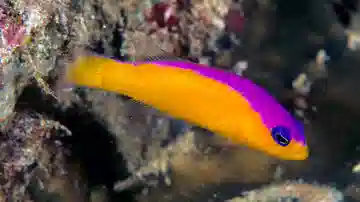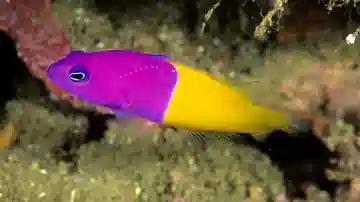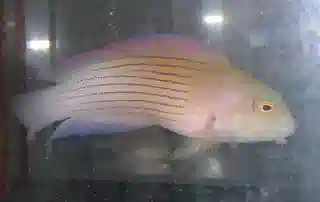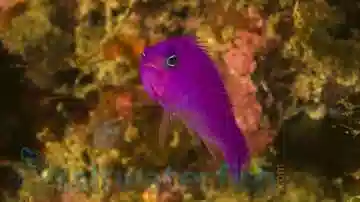Purple Pseudochromis
Pictichromis porphyreus
(44 Reviews)

Purple Pseudochromis
Pictichromis porphyreus
(44 Reviews)
{{ item.name }}
Size: {{ item.extra_field_3 }}
${{ getFormattedPrice(item.saleprice) }} ${{ getFormattedPrice(item.price) }}
To join the waiting list, click here
Free Shipping
With
$199.00
or more in Marine Life.
More details...
Purple Pseudochromis Care Facts
| Care Level: | Easy |
|---|---|
| Temperament: | Semi-Aggressive |
| Diet: | Canivore |
| Reef Safe: | Yes |
| Minimum Tank Size: | 30 gallons |
| Max Size: | 3 inches |
Purple Pseudochromis (Pictichromis porphyrea): Vibrant Cave-Dwelling Reef Fish
The Purple Pseudochromis displays stunning pink-purple coloration that intensifies with proper nutrition and lighting. These hardy cave-dwelling fish make excellent additions to reef aquariums when their territorial requirements are accommodated through proper aquascaping and species selection.
Habitat and Natural Behavior:
Native to Indo-Pacific coral reefs, Purple Pseudochromis are specialized cave and crevice dwellers that establish defined territories around preferred rock formations. In captivity, they require complex rockwork with multiple cave systems to express natural behaviors.
Size, Lifespan, and Characteristics:
- Adult Size: 3 inches maximum
- Lifespan: 5-8 years with proper care
- Sexual Dimorphism: Males display more intense coloration and slightly larger size
- Behavior: Active cave-dwelling with territorial tendencies that develop after acclimation
Territorial Behavior and Tank Planning:
Purple Pseudochromis exhibit peaceful behavior initially but establish territories 2-4 weeks after introduction. Success requires understanding their cave-dwelling nature and providing appropriate rockwork structure.
Territory Requirements:
- Multiple cave systems with single entrances
- Complex rockwork creating territorial boundaries
- Sight-line breaks to prevent constant visual contact
- 12-18 inch territory zones around chosen caves
Tank Requirements:
- Minimum Size: 30 gallons for single specimen
- Preferred Size: 50+ gallons for better territorial management
- Aquascaping: Essential complex rockwork with multiple caves
- Water Parameters: pH 8.1-8.4, Salinity 1.024-1.026, Temperature 76-80°F
- Lighting: Tolerates all reef lighting levels, prefers moderate areas
Diet and Feeding:
Carnivorous species requiring protein-rich foods:
- High-quality marine pellets (primary diet)
- Frozen mysis shrimp and enriched brine shrimp
- Marine copepods and small crustaceans
- Feed 2-3 times daily in small portions
Reef Compatibility:
Completely reef-safe with no interest in corals or beneficial invertebrates. Their carnivorous diet and cave-dwelling behavior make them excellent choices for reef systems.
Compatible Tank Mates:
Best Choices: Mid-water swimmers, sand-dwelling species, and fish that utilize different territory types:
- Chromis species (single specimens)
- Cardinalfish utilizing open water areas
- Sand-sifting gobies
- Peaceful wrasses
- Large peaceful fish in 75+ gallon systems
Species to Avoid:
- Royal Gramma (territorial competition)
- Other dottyback species
- Small peaceful fish under 2 inches
- Other cave-dwelling basslets
Aquaculture Availability:
Successfully bred in captivity but primarily available as wild-caught specimens. Wild specimens are hardy and adapt well when provided with appropriate cave territories.
Important Note: Purple Pseudochromis may appear peaceful initially but develop territorial behavior as they mature and establish cave territories. Tank planning should accommodate this natural progression.
Ideal for: Reef aquarists with experience in territorial species management seeking a hardy, colorful cave-dwelling centerpiece fish for appropriately designed systems.
Reviewed by: Erica Cohn on July 15, 2025
Reviewed by: Darin Bass on July 13, 2025
Very nice
Reviewed by: Bobbi Link on Dec. 15, 2024
Bright, very colorful.
Reviewed by: Shaun Huddleston on Oct. 23, 2024
Reviewed by: Paige Hutchinson on Oct. 20, 2024
Good fish.
Reviewed by: Tuan Tran on Oct. 18, 2024
Beautiful
Reviewed by: Scott Olson on Oct. 9, 2024
Love it
Reviewed by: Scott Olson on Sept. 29, 2024
Reviewed by: Gary Sparks on Sept. 11, 2024
Reviewed by: Gary Sparks on Sept. 9, 2024
Great color and very healthy
Reviewed by: Anthony Balatti on Sept. 1, 2024
Adds great color to the reef, nice specimen.
Reviewed by: Timothy Thomas on Aug. 28, 2024
Bright colored
Reviewed by: Shaun Huddleston on July 18, 2024
Great purple color
Reviewed by: Jim Hauck on July 8, 2024
Reviewed by: Jana Hess on July 6, 2024
Reviewed by: Jana Hess on June 24, 2024
Very shy but throw food in the tank and. Join right away
Reviewed by: Alvin Barbes on June 17, 2024
Reviewed by: Billy Springer on May 13, 2024
Everything was great will order again soon
Reviewed by: Alan Amtmann on April 30, 2024
Reviewed by: Debra K Mabrey on April 3, 2024
Really fast shipping was very happy with the fish looking to buy a lot more
Reviewed by: Richard Staats on Jan. 29, 2024
Beautiful color
Reviewed by: Mike Perdue on Jan. 17, 2024
Reviewed by: Jason Salyer on Jan. 16, 2024
Great
Reviewed by: Edward A Wilburn on Jan. 12, 2024
Absolutely love this fish! Brings so much color to the tank and is actually very well behaved and gets along with all my fish, even the ones you would think he would be territorial with. A great addition to your tank if you already don't have one.
Reviewed by: Dale Pichelmayer on Jan. 10, 2024
Reviewed by: Laurence Somers on Dec. 25, 2023
Found homes right away.
Reviewed by: Jerry Albright on Dec. 18, 2023
Vibrant and active
Reviewed by: James Miller on Dec. 11, 2023
Reviewed by: Debbie Konechney on Dec. 11, 2023
Reviewed by: Hayden Hendricks on Nov. 26, 2023
What a beautiful magenta color. They're more active each day
Reviewed by: Eric Wilson on Oct. 29, 2023
Reviewed by: Brad Fritza on Oct. 28, 2023
Reviewed by: Eric Wilson on Oct. 24, 2023
Reviewed by: Laurence Somers on Oct. 14, 2023
This guy is doing great in quarantine after less than a week and i hope he does well in my DT
Reviewed by: Jim Minor on Sept. 24, 2023
Color is beautiful. Love the different color in my tank
Reviewed by: Kim Smith on Sept. 13, 2023
Reviewed by: Woody Johnson on Sept. 6, 2023
Reviewed by: Richard Walker on Aug. 8, 2023
Beautiful fish, active and eating within a few days.
Reviewed by: Laurence Somers on Aug. 4, 2023
Reviewed by: Susan Alexandre on July 24, 2023
Reviewed by: John Cordova on June 28, 2023
Had mine for 2 years and it was good with all other fish and invertebrates. I did have a very small hole in my lid for my filtration, and it found it. Was looking for it for a few days till I found it behind the tank on the floor. Beautiful fish. Make sure on your lid.
Reviewed by: John Atella on June 7, 2022
I received this about 10 days ago. The little guy hits in the rocks but swims out for a bit. It is settling in nicely and the color is a deep purple. A very pretty addition!
Reviewed by: Eric Roberts on Aug. 22, 2016
An absolutely gorgeous fish! He quickly made friends with my other fish, and his color looks so pretty in my tank.
Reviewed by: Lisa on July 3, 2015















